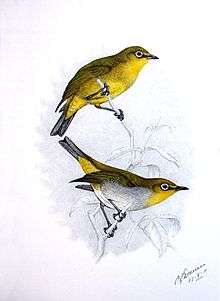Cape white-eye
| Cape white-eye | |
|---|---|
 | |
| Ssp. virens upper, capensis lower | |
| Not recognized (IUCN 3.1) | |
| Scientific classification | |
| Kingdom: | Animalia |
| Phylum: | Chordata |
| Class: | Aves |
| Order: | Passeriformes |
| Family: | Zosteropidae |
| Genus: | Zosterops |
| Species: | Z. virens |
| Binomial name | |
| Zosterops virens Sundevall, 1850 | |
The Cape white-eye (Zosterops virens) is a small passerine bird in the white-eye family. It is native to southern Africa.
Taxonomy
There are two subspecies. The western nominate group is now treated as separate species; the Orange River white-eye (Z. pallidus) and the Cape white-eye (Z. virens). The latter can be further divided into two subgroups, the south-western capensis subgroup and the eastern virens subgroup (the so-called green white-eye). All subspecies interbreed where they come into contact (including members of the nominate group with members of the capensis group of both subgroups in Free State).

Identification
This species is about 12 cm long with rounded wings, strong legs, and a conspicuous ring of white feathers round the eyes. The upperparts are green, and the throat and vent are bright yellow. The members of the nominate group have a pale yellow central belly with peach coloured flanks. The members of the capensis subgroup have a grey breast and belly, while the virens subgroup have a greenish-yellow breast and belly.
They are very vocal, and constantly keep in touch with soft trilled pee, pree or pirreee callnotes. The song consists of repeated long jerky phrases of sweet reedy notes, varying in pitch, volume and temp, usually starting off with teee teee or pirrup pirrup notes, then becoming a fast rambled jumble of notes, which may incorporate mimicked phrases of other birdcalls.
Behaviour
This is a sociable species forming large flocks outside the breeding season. It builds a cup nest in a tree and lays 2-3 unspotted pale blue eggs. The eggs hatch in 11–12 days, and fledging occurs in another 12–13 days. The peak breeding season is September to December.
The Cape white-eye feeds mainly on insects, but also soft fleshy flowers, nectar, fruit and small grains. It readily comes to bird feeders.
Distribution
It is found in a wide range of densely to lightly wooded habitats in South Africa, Botswana, Mozambique, Lesotho and Swaziland. Most populations are resident, but some perform minor seasonal movements.
References
- Sinclair, Hockey and Tarboton, SASOL Birds of Southern Africa, ISBN 1-86872-721-1
External links
- Cape White-eye - Species text in The Atlas of Southern African Birds